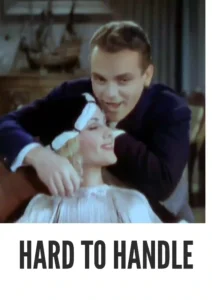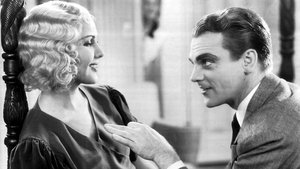Video Sources 0 Views
- Watch trailer
- Hard to Handle 1933 Colorized


Synopsis
Table of Contents
ToggleFast-Talking Hustlers and Hilarious Schemes: Hard to Handle (1933) in Stunning Color

Dive into the whirlwind world of the 1930s with Hard to Handle, a riotous screwball comedy from 1933, now brilliantly colorized for a fresh and engaging viewing experience. Starring the charismatic James Cagney, this pre-code gem showcases fast-talking confidence men and their outrageously funny schemes. Perfect for fans of classic comedies and those looking for a lighthearted escape, this HD download offers a delightful journey back to the golden age of cinema.
Hard to Handle Storyline: A Wild Ride of Cons and Capers
Hard to Handle centers on the escapades of Lefty Merrill (James Cagney), a resourceful and quick-witted con artist always on the lookout for his next big score. Set against the backdrop of the Depression-era, the film follows Lefty as he navigates a series of elaborate schemes, from staging phony beauty contests to promoting questionable products.Along the way, Lefty crosses paths with Ruth Waters (Mary Brian), an aspiring actress whom he tries to help, often with hilarious and chaotic results. Their relationship adds a charming romantic subplot to the film’s comedic mayhem. As Lefty’s cons become more ambitious, he finds himself in increasingly precarious situations, leading to a series of uproarious encounters and unexpected twists. Ultimately, Hard to Handle is a fast-paced and thoroughly entertaining comedy that highlights the energy and humor of early Hollywood cinema.
Movie Cast
The film boasts a stellar cast that brings the comedic story to life:
- James Cagney as Lefty Merrill
- Mary Brian as Ruth Waters
- Allen Jenkins as Spider
- Ruth Donnelly as Lil Waters
- Claire Dodd as Marlene Reeves
Movie Genre
Hard to Handle is a screwball comedy, characterized by its fast-paced dialogue, slapstick humor, and absurd situations. It exemplifies the pre-code era of Hollywood, featuring risqué humor and unconventional characters that challenged social norms of the time.
Historical Context: Pre-Code Hollywood and Comedic Innovation
Released in 1933, Hard to Handle captures the irreverent spirit of pre-code Hollywood, a period known for its daring and boundary-pushing films. This era allowed for greater creative freedom, resulting in comedies that were more satirical and provocative than those produced under stricter censorship. Hard to Handle showcases the comedic talents of James Cagney, demonstrating his versatility beyond his tough-guy roles, and reflects the changing landscape of American cinema during the early 1930s.
Colorization Details
This colorized version of Hard to Handle has been meticulously restored using state-of-the-art digital techniques, enhancing the visual experience while maintaining the film’s original charm and comedic timing. The colorization process involved a detailed analysis of the original black and white footage, with careful attention to period-accurate colors and textures. Through the use of advanced software algorithms and skilled artistry, the characters and settings come to life in vibrant hues, adding a new layer of enjoyment for modern audiences. The goal of this process is to introduce classic films to a broader audience, ensuring that these cinematic treasures are appreciated for generations to come.
Technical Details
- Director: Mervyn LeRoy
- Screenplay: Wilson Mizner, Robert Lord
- Story: “Alias the Deacon” by Borden Chase
- Cinematography: Robert Kurrle
- Edited by: William Holmes
- Production Company: Warner Bros. Pictures
- Distributed by: Warner Bros. Pictures
- Runtime: 90 minutes
Technical Specifications
- Download Format: MP4
- Resolution: HD (1080p)
- Compatibility: Compatible with most devices, including smartphones, tablets, computers, and smart TVs.
Reviews and Critical Reception
Hard to Handle (1933) is celebrated for its witty dialogue, energetic performances, and fast-paced comedic action. James Cagney’s charismatic portrayal of a con artist is a highlight, showcasing his comedic talents and versatility as an actor. As a prime example of pre-code Hollywood, the film offers a glimpse into a more daring and experimental era of filmmaking, making it a must-see for fans of classic comedy.
FAQs
- Q: What is Hard to Handle about?
- A: Hard to Handle is a screwball comedy about a con artist who navigates a series of hilarious schemes during the Depression-era.
- Q: Is Hard to Handle (1933) a well-known James Cagney film?
- A: While not as famous as some of his gangster roles, Hard to Handle is a notable film that showcases Cagney’s comedic talents.
- Q: Is this version of Hard to Handle colorized?
- A: Yes, this version has been professionally colorized to enhance the viewing experience.
- Q: What makes Hard to Handle interesting for classic film fans?
- A: Hard to Handle offers a glimpse into the pre-code era of Hollywood, known for its daring and boundary-pushing comedies.
- Q: What is the download format?
- A: The download format is MP4, which is compatible with most devices.
- Q: What resolution is the download?
- A: The resolution is HD (1080p), providing a high-quality viewing experience.
Download Now in HD!
Watch Hard to Handle Today!












